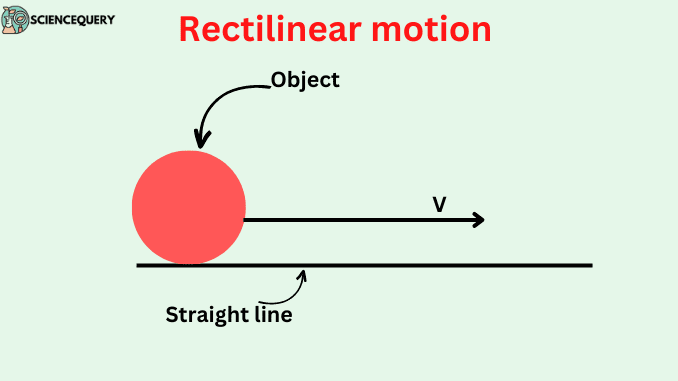
Know in one minute about Rectilinear motion
|
Introduction
Rectilinear motion is a specific type of motion in which an object moves along a straight line. It is a very important part of mechanics.
There are several types of motions: linear, rectilinear, circular, and projectile motion, etc. Among all of these, rectilinear motion is the simplest form of motion in the physics world.
Rectilinear motion
Rectilinear refers to a path that is like a straight line, that is, the body does not take any kind of turn during the motion. Hence,
“When a body moves along a straight line or parallel to a straight line, then the motion of the body is called rectilinear motion.”
To remember this, we can keep these points in mind:
- The object or particle must move in a straight line.
- For this type of motion, we only need one axis.
- The direction and other terms related to the mechanics of a moving object or particle such as velocity, acceleration, etc. do not change.
- This is a different type of motion than linear motion.
Examples
1. Trains running on the tracks: Since the tracks are straight and there is no bend in them, the movement of the train on the tracks.
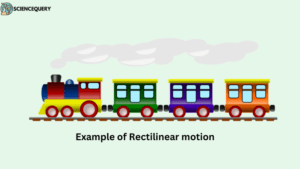
2. Elevators: elevators do rectilinear motion because they move in a straight line path by strings.
3. Falling of an object from height: When we drop something from some height above the ground, it follows a straight-line path and does not change its direction.
4. Swimmer’s motion: The swimmer at the time of the swimming competition, swims only at one axis.
Distance and Displacement in rectilinear motion
Distance and displacement are the terms that refer to the change in position of any object or particle.
In this, position changes only along with the straight path taken.
So, we can define these terms as
Distance
The total length of the path during the whole journey is called distance. It is denoted by s
Displacement
The shortest distance between the starting point and end point of the journey is called displacement. It is denoted by ![]() .
.
Here, the direction of displacement will only be positive or negative along an axis.
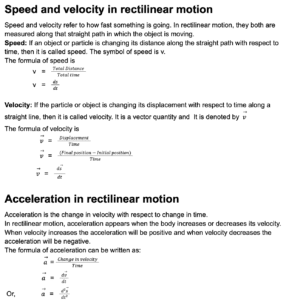
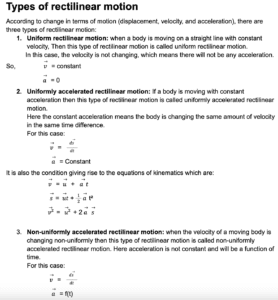
Some examples for better understanding
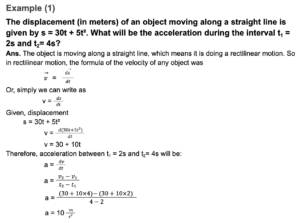
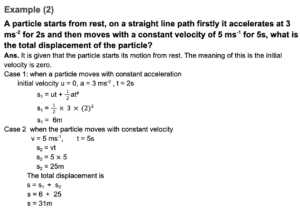
Difference between linear and rectilinear motion
Key points |
Linear motion |
Rectilinear motion |
| Definition | Here the object moves along a line, whether the line is curved or straight. | Object moves along a straight line, and during this motion, it does not take any kind of turn. |
| Dimensions | It can be in the form of a straight line in one dimension, as well as when motion occurs in a curved path, it can be in two dimensions. | Occur in only one dimension. |
| Conditions of motion | Follows circular, zig-zag, and curved paths. | Happens only on one axis out of the X, Y, or Z axis. |
| Relation | It is the parent motion as it can occur in both one and two dimensions. | It is a type of linear motion. |
| Examples | Vehicles running on curved roads trains running on tracks, the earth revolving around the sun, etc. | movement of trains on tracks, the motion of elevators, etc. |
Q&A
1. What is the definition of rectilinear motion?
Ans. It is a type of linear motion in which when an object or a particle moves along a straight line.
2. Describe examples of rectilinear motion.
Ans. Examples are given as follows:
- The motion of vehicles while crossing a straight bridge.
- When a fruit falls from a tree.
- Elevators.
- A trolley moving on a mountain on a ropeway with the help of a straight wire does.
3. What is the difference between rectilinear and curvilinear motion?
Ans.
Rectilinear motion |
Curvilinear motion |
| It is a type of linear motion in which the body travels in a straight line. | This is also a type of linear motion in which the body moves on a curved line path. |
| In this, the body does motion only along one axis. | In this, the body moves on two axes. |
| On the same axis on which the body moves, it is possible to have only two directions of the body – positive and negative. | In this the body moves along two axes, accordingly, it keeps on changing the direction on the plane of motion. |
| The train’s motion on its track and the elevator’s motion are examples. | Snake’s motion, and the turning of a car on a curvy path, are examples of curvilinear motion. |
4. How to find maximum velocity in rectilinear motion?
Ans. Firstly we differentiate the time-varying function of displacement with respect to time.
v = ds/dt
When we get the function of velocity, we simply put this function equals zero and find the time at maximum velocity.
ds/dt = 0
By putting this time into the velocity function, we get maximum velocity.
Written by: Amber Soni
References
NEET Objective PHYSICS Volume 1, By DC Pandey, Arihant Prakashan, Meerut, page no. 88-99

